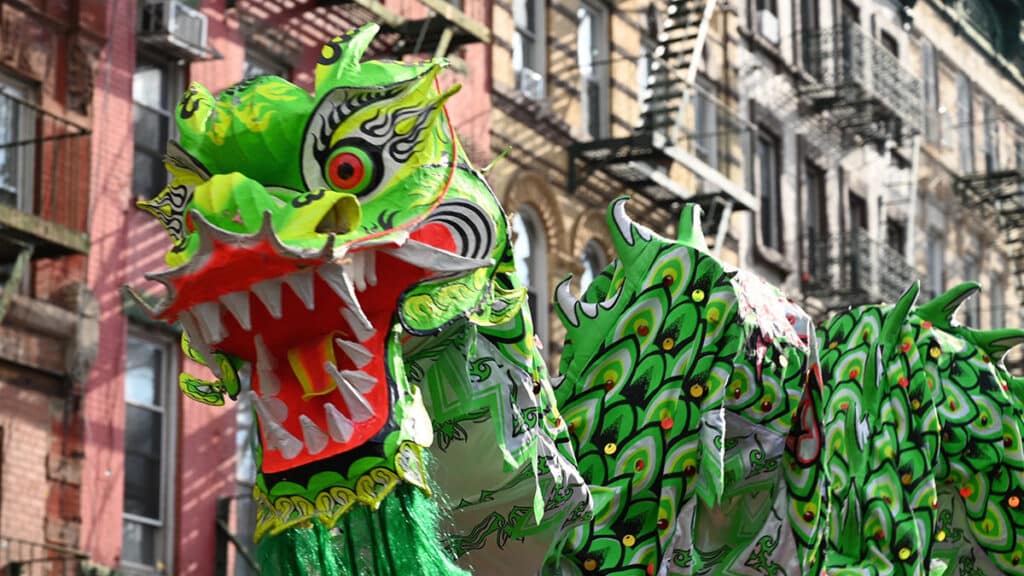Lunar New Year 2024 Year of the Dragon Festival runs from February 10-25, 2024.
Lunar New Year NYC 2024

Lunar New Year NYC 2024 brings back the usual celebrations.
- Lunar New Year Firecracker Ceremony and Cultural Festival opens the Festival at Sara D. Roosevelt Park at Grand St in Manhattan’s Lower East Side (Manhattan Chinatown); on Saturday, February 10, 2024.
- Chinese New Year Parade closes the festival in Manhattan, Chinatown on Sunday, February 25, 2024. The route is:
- Down Mott St from Hester St to Chatham Square.
- Across East Broadway to Eldridge St.
- Up Forsyth St to Broom St.
Lunar New Year
Lunar New Year is the East Asian spring festival. It’s earlier than European spring festivals, but around this time is when we see the first hints of spring. In the Caribbean, we notice the courting and nesting behavior of the Caribbean blackbird (grackle). It’s when the birds start getting busy. Their courting displays are fun to watch. Indigenous Peoples of the Americas originated in Northern Asia, and some celebrate Lunar New Year too.
Though often called Chinese New Year, it is not only Chinese. Lunar New Year is celebrated in cultures across East and Southeast Asia. Every country has its own traditions, but all are bear the ancient influence of a large Chinese Diaspora. China calls it the Spring Festival. Vietnam calls it Tet. Korea calls it Seollal.
We tend to focus on the full moon, but metaphysically, things start on the new moon. So Lunar New Year starts on the first new moon of the lunar calendar and ends fifteen days later on the full moon. The first new moon can fall anywhere from late January to mid-February.
The celebration consists of family gatherings around traditional food, community carnivals, and parades. Fireworks are lit to scare away bad spirits to make a prosperous new year. Like other traditions, we clean our homes and may add furniture and decorations to the house.
At this time of year, we eat special dumplings and rice cakes.
In life, you receive what you give. Chinese culture is very symbolic, so we enjoy foods and gifts that represent wealth. Oranges, kumquats, and the like are traditional. Businesses put small orange trees outside their doors and decorate them with money for the lion or dragon dancers to come through to pick. It’s an old-fashioned shake down. If you don’t put out enough money, you may have problems with the youth organizations later. Families give children money in red envelopes. Of course, kids love the tradition. You can find the little red envelopes in all of New York City’s Chinatowns.
Most traditional cultures practice ancestral veneration, and we put offerings to our ancestors on home altars. Every Asian restaurant in New York City has one of these altars.
The dragon is one of the great mythical creature of East Asian culture. But dragons are afraid of fire and loud noises, so we decorate with lots of red and light firecrackers to scare away the bad ones.
Every Lunar New Year is represented by an animal from the zodiac. The Chinese zodiac has twelve animals: rat, ox, tiger, rabbit, dragon, snake, horse, goat, monkey, rooster, dog, and pig. The Vietnamese zodiac replaces the rabbit with a cat, and the ox with a buffalo.
By tradition, people take on the characteristics of the animal of the year in which they were born. Some countries will have spikes in the number of births this year as parents plan for good fortune. [Editor “Kíko” Keith: I happen to be part Chinese descent and was raised as a child in Old Los Angeles Chinatown. I’m a rat and actually do have its traditional characteristics. The rat is able to adapt to most any situation. I live all over the world in cultures and languages that are not native. The rat is shy, but can be aggressive. I observe first to see what’s going on, but as a New Yorker can be assertive in pursuit of my goals. In my case, the traditions hold true.]
Year of the Dragon
In Chinese tradition, 2024 is the Year of the Dragon.
The dragon represents good luck, justice, prosperity, and strength. People born this year have leadership qualities of charisma, intelligence, and confidence. They are gifted, naturally lucky, and often powerful.
As in Caribbean culture, metaphysical characters have many different faces or characters. This Year of the Dragon is a wood dragon. People born this year are introverted, but make good leaders because they are dedicated to their work.
Southeast and East Asian Buddhist cultures replace the dragon with the naga, a half-human, half-serpent creature. Some Nepalese replace it with an eagle. OId Turks celebrate a fish or crocodile. Old Persians celebrate a sea serpent or whale.
